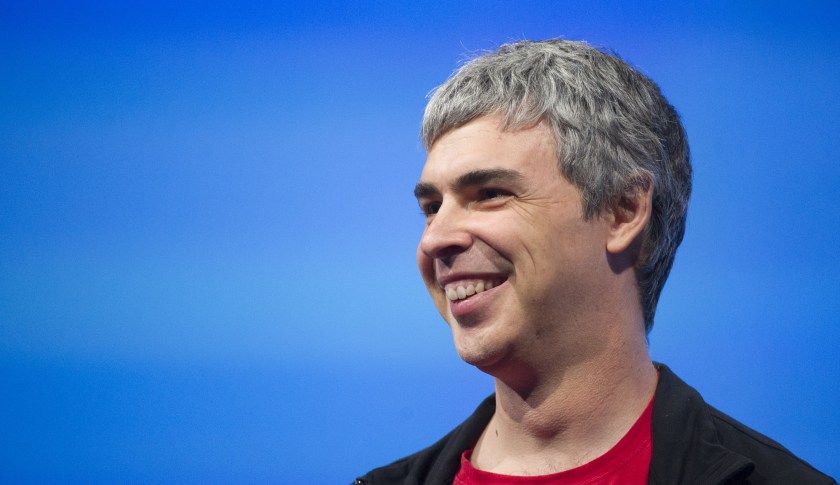For years, Google CEO Larry Page had dreamed about a tantalizing possibility: using balloons, rather than satellites, for communications.
多年来,谷歌公司(Google)首席执行官拉里o佩奇一直怀揣着一个美妙的梦想,那就是用气球代替卫星进行通讯。
There were plenty of reasons why the idea was interesting. Satellites take years to build and cost millions of dollars to build and launch. For someone used to releasing products in “beta,” and perfecting them through rapid iteration, this was a huge barrier to innovation. “You’re pretty averse in your development of these things,” Page said during a recent interview. What’s more, the cost and time involved in a launch often led to technology lock-in—if something you’ve invested millions in works, you’re going to stick with it rather than trying to perfect it and risk a setback.

这个想法很有意思,原因是多方面的。制造并发射一颗卫星需要几年时间,还要耗费数百万美元资金。对习惯于发布“测试版”产品并通过快速迭代来予以完善的人来说,这是一个巨大的创新障碍。佩奇最近接受采访时说:“在开发这些东西时会遇到相当大的抵触。”此外,为推出新产品而投入的成本和时间经常会产生技术锁定效应——如果你为某项工作投入了几百万美元,你就会坚持使用其中的技术,而不会冒着受挫的风险来设法完善它。
Balloons offered an alternative. What if you could launch a balloon, test it, bring it down, learn something, and repeat, all in the course of a day? Then, you could go back and do it all over the next day. “It’s a natural question to ask,” Page said.
气球提供了另一种通讯方式。假如能在一天内完成放出气球、测试、回收、吸取经验教训、然后再来一遍的过程,会怎么样呢?而且,第二天还可以追溯、重复这个过程。佩奇说:“人们自然会问这样的问题。”
It was also a crazy enough idea that no one was working on it. To Page, that was a classic “zero million dollar” research problem. “You find no one working on it,” he said. “And you know that zero million dollars are going into that problem.”
同时,这个想法很疯狂,还没有人付诸实施。对佩奇来说,这是一个经典的“零起步百万美元”研究课题。他指出:“你会发现没有人开展这项工作,你也知道还没有人为此投入资金。”
Many of Google’s moonshots—self driving cars, high-altitude wind turbines, and most recently ingestible nano-particles for early detection of cancer—started as zero million dollar problems. And as no one was working on them, Google was able to attract some of the top people in field, which Page says gives the company a huge advantage.
谷歌许多“探月计划”都从这些起步为零的百万美元课题开始,比如无人驾驶汽车和高海拔风力发电机,以及最近用于检测早期癌症的可服用纳米技术微粒。同时,由于还没有人从事这些研究,谷歌得以把这些领域的一些顶尖人才招至麾下。佩奇说这给谷歌带来了巨大的优势。
But not every crazy idea is worth pursuing. So how do you sort the crazy-but-possible ideas from the plain crazy ones? Page said Google takes a methodical and gradual approach.
但并非每个疯狂的想法都值得实施。那么,如何区分那些疯狂但有可能的想法与纯粹的狂想呢?佩奇表示,谷歌采用一个系统性的渐进方式。
A big question with balloons was whether they could stay up long enough—weeks or months on end—on a regular basis to be useful for communications. Ballooning experts believed it was impossible.
通讯气球的一大问题是悬浮时间是否足够长。要用于通讯的话,通常情况下气球需在空中停留几个星期,甚至几个月。气球专家认为这绝不可能。
Page took to Google, of course, to search and search and search. “Eventually I found this balloon image from 1960 that had gone around the Earth like five times,” he said. “If somebody in 1960 can do that, we can do that. We have better materials.”
当然,佩奇在谷歌上进行了反反复复的搜索:“最终我找到了这幅1960年的气球图片,它曾绕着地球飞行了大概五次。如果1960年的人能做到这一点,我们也能做到。我们有更好的材料。”
Today, Project Loon, which the company’s moonshot lab, Google X, unveiled last year, is testing a fleet of balloons that are routinely staying up in the air for 100 days at a time. They’ve covered more than 3 million kilometers, or about 2 million miles. In tests with telecommunications companies in Australia, New Zealand and Chile, they’re delivering speeds of 10 megabits per second to rural areas.
如今,Project Loon正在对一批气球进行测试——谷歌的“探月”实验室Google X去年披露了这个项目。测试气球通常每次都能在空中停留100天,其累计漂浮的距离已超过300万公里。与澳大利亚、新西兰和智利电信公司联合开展的测试表明,这些气球能为农村地区提供10MB/秒的通讯带宽。
Page’s idea is no longer a zero million dollar problem. Google has invested millions in the projects, hired top scientists and conducted hundreds of tests in different environments. But at the genesis of this, and several other moonshots, there were some key ingredients: Page’s natural curiosity and his impulse for self-directed learning, which he traces to his education in a Montessori school.
佩奇的想法再已不再是零起步百万美元课题。谷歌已经为这些项目投入了数百万美元,聘请了顶尖科研人员,并在不同环境下进行了几百次测试。究其根源,这些“探月”项目源于两个关键因素:佩奇天生的好奇心和他进行自主学习的冲劲。佩奇说这种冲劲源于自己在蒙特梭利学校(Montessori school)接受的教育。
“How do you play detective a little bit and then how do you convert that into things that can transform how a billion people can get their connectivity,” he said. “That’s the exciting part.”
他说:“如何稍稍进行一些探究,然后如何把结果转化成可以改变10亿人通讯方式的产品,这是最激动人心的部分。”
Exciting. And fairly straightforward—at least if you’re the world’s most ambitious CEO. “You see some evidence that it’s possible and you try to figure things out,” Page said. “And you say, well, maybe that’s the question we should be asking.”
激动人心。这样的说法很是直截了当——至少对世界上最有胆识的首席执行官来说是这样。佩奇表示:“当你看到一些证明某件事可行的证据时,你就得尽力把事情弄清楚。你会说,也许这就是我们该问的问题。”












